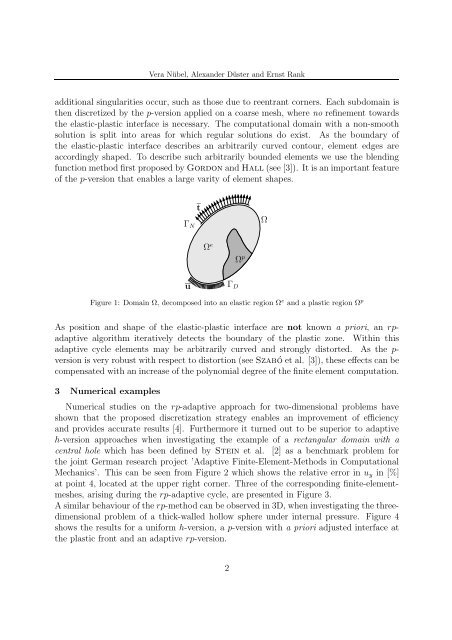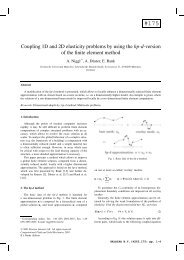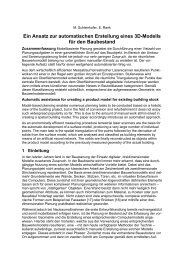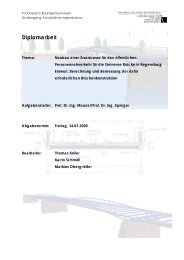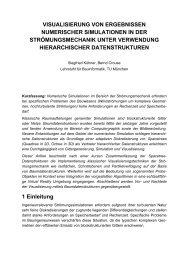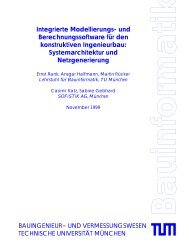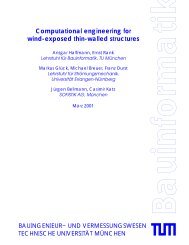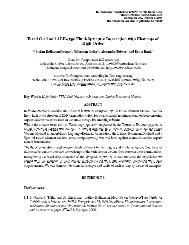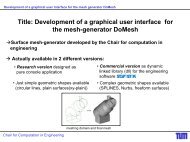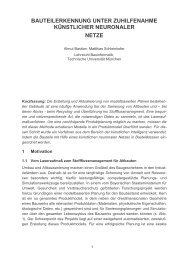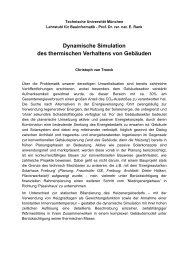an rp-adaptive finite element discretization applied to physically non ...
an rp-adaptive finite element discretization applied to physically non ...
an rp-adaptive finite element discretization applied to physically non ...
You also want an ePaper? Increase the reach of your titles
YUMPU automatically turns print PDFs into web optimized ePapers that Google loves.
Vera Nübel, Alex<strong>an</strong>der Düster <strong>an</strong>d Ernst R<strong>an</strong>kadditional singularities occur, such as those due <strong>to</strong> reentr<strong>an</strong>t corners. Each subdomain isthen discretized by the p-version <strong>applied</strong> on a coarse mesh, where no refinement <strong>to</strong>wardsthe elastic-plastic interface is necessary. The computational domain with a <strong>non</strong>-smoothsolution is split in<strong>to</strong> areas for which regular solutions do exist. As the boundary ofthe elastic-plastic interface describes <strong>an</strong> arbitrarily curved con<strong>to</strong>ur, <strong>element</strong> edges areaccordingly shaped. To describe such arbitrarily bounded <strong>element</strong>s we use the blendingfunction method first proposed by Gordon <strong>an</strong>d Hall (see [3]). It is <strong>an</strong> import<strong>an</strong>t featureof the p-version that enables a large varity of <strong>element</strong> shapes.PSfrag replacementsΓ NtΩΩ eΩ puΓ DFigure 1: Domain Ω, decomposed in<strong>to</strong> <strong>an</strong> elastic region Ω e <strong>an</strong>d a plastic region Ω pAs position <strong>an</strong>d shape of the elastic-plastic interface are not known a priori, <strong>an</strong> <strong>rp</strong><strong>adaptive</strong>algorithm iteratively detects the boundary of the plastic zone. Within this<strong>adaptive</strong> cycle <strong>element</strong>s may be arbitrarily curved <strong>an</strong>d strongly dis<strong>to</strong>rted. As the p-version is very robust with respect <strong>to</strong> dis<strong>to</strong>rtion (see Szabó et al. [3]), these effects c<strong>an</strong> becompensated with <strong>an</strong> increase of the polynomial degree of the <strong>finite</strong> <strong>element</strong> computation.3 Numerical examplesNumerical studies on the <strong>rp</strong>-<strong>adaptive</strong> approach for two-dimensional problems haveshown that the proposed <strong>discretization</strong> strategy enables <strong>an</strong> improvement of efficiency<strong>an</strong>d provides accurate results [4]. Furthermore it turned out <strong>to</strong> be superior <strong>to</strong> <strong>adaptive</strong>h-version approaches when investigating the example of a rect<strong>an</strong>gular domain with acentral hole which has been defined by Stein et al. [2] as a benchmark problem forthe joint Germ<strong>an</strong> research project ’Adaptive Finite-Element-Methods in ComputationalMech<strong>an</strong>ics’. This c<strong>an</strong> be seen from Figure 2 which shows the relative error in u y in [%]at point 4, located at the upper right corner. Three of the corresponding <strong>finite</strong>-<strong>element</strong>meshes,arising during the <strong>rp</strong>-<strong>adaptive</strong> cycle, are presented in Figure 3.A similar behaviour of the <strong>rp</strong>-method c<strong>an</strong> be observed in 3D, when investigating the threedimensionalproblem of a thick-walled hollow sphere under internal pressure. Figure 4shows the results for a uniform h-version, a p-version with a priori adjusted interface atthe plastic front <strong>an</strong>d <strong>an</strong> <strong>adaptive</strong> <strong>rp</strong>-version.2


